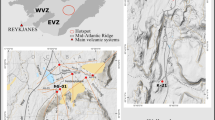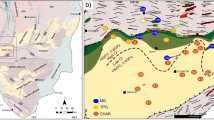Abstract
THERE is a considerable body of geological evidence suggesting that, in a submarine environment, extrusion of silicate liquids with a composition comparable to peridotite occurs. Later, this material is hydrated to form serpentine. In part, this evidence comes from repeated association of serpentines with marine sediments such as greywackes and cherts, and repeated association with volcanics including pillow lavas. Further, the ultramafics of this environment show features to be expected from rocks which have flowed. An excellent description of such a situation is provided by Bailey and McCallien1. Hess2 has summarized some of the data from field evidence suggesting that many ultrabasic rocks were formed by intrusion of liquids. But laboratory investigation has consistently heaped difficulties on an extrusive explanation of such rocks. Known surface lava temperatures do not exceed 1,200° C. while the melting temperatures of the anhydrous equivalents of serpentine are of the order of 1,700° C. Clearly there are difficulties in moving such materials to the surface of the Earth, or even in forming liquids at reasonable depths in the crust. The following statement from Hess2 bears repeating : “For most of this century a magnificent argument has gone on between field geologists who have worked on the peridotites of alpine mountains and laboratory investigators of their chemistry (particularly Bowen). The former stoutly maintains that the evidence indicates that they were intruded in a fluid state, as magmas; and the latter equally forcefully has proved to his satisfaction that such magmas are not possible… At the other extreme we find Bailey and McCallien suggesting that the serpentines of Turkey are submarine lava flows.”
This is a preview of subscription content, access via your institution
Access options
Subscribe to this journal
Receive 51 print issues and online access
$199.00 per year
only $3.90 per issue
Buy this article
- Purchase on Springer Link
- Instant access to full article PDF
Prices may be subject to local taxes which are calculated during checkout
Similar content being viewed by others
References
Bailey, E. B., and McCallien, W. J., Trans. Roy. Soc. Edin., 62, Part 2, 403 (1953).
Hess, H. H., Geol. Soc. Amer. Special Paper, 62, 391 (1955).
Turner, F. J., and Verhoogen, J., Igneous and Metamorphic Petrology (McGraw-Hill, New York, 1960).
Author information
Authors and Affiliations
Rights and permissions
About this article
Cite this article
CLARK, R., FYFE, W. Ultrabasic Liquids. Nature 191, 158–159 (1961). https://doi.org/10.1038/191158a0
Issue Date:
DOI: https://doi.org/10.1038/191158a0
This article is cited by
-
Die Möglichkeit der Entstehung ultrabasischer Magmen bei Gegenwart geringer Alkalimengen
Geologische Rundschau (1968)
-
Structure and petrology of an alpine peridotite on Cypress Island, Washington, U.S.A
Beitr�ge zur Mineralogie und Petrographie (1965)
-
Altered Lavas from the Floor of the Eastern North Atlantic
Nature (1962)
-
Ultrabasic Liquids
Nature (1961)
Comments
By submitting a comment you agree to abide by our Terms and Community Guidelines. If you find something abusive or that does not comply with our terms or guidelines please flag it as inappropriate.



